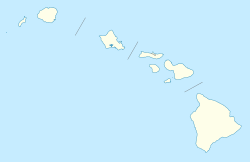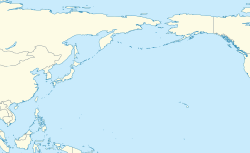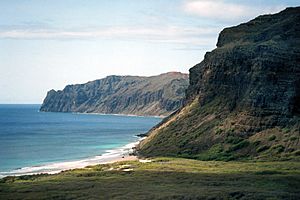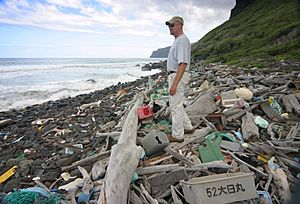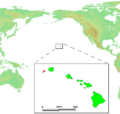Niihau facts for kids
|
Nickname: The Forbidden Isle
|
|
|---|---|
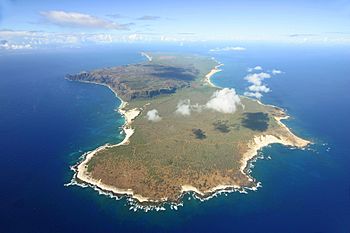
Aerial view of Niʻihau looking southwestward from the northeast
|
|
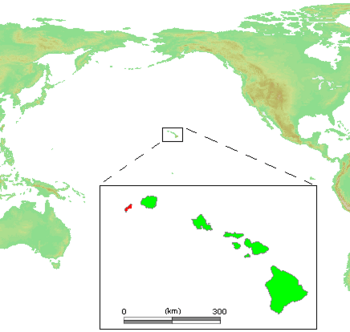
Location of Niʻihau in the state of Hawaiʻi
|
|
|
Location of Niʻihau in the state of Hawaiʻi
|
|
| Geography | |
| Location | North Pacific Ocean |
| Coordinates | 21°54′N 160°10′W / 21.900°N 160.167°W |
| Area | 69.5 sq mi (180 km2) |
| Area rank | 7th largest Hawaiian Island |
| Highest elevation | 1,250 ft (381 m) |
| Highest point | [[Mount Pānīʻau]] |
| Administration | |
|
United States
|
|
| State | Hawaiʻi |
| County | Kauaʻi |
| Owner(s) | Bruce Robinson Keith Robinson |
| Symbols | |
| Flower | Pūpū keʻokeʻo (white shell) |
| Color | Keʻokeʻo (white) |
| Largest settlement | Puʻuwai |
| Demographics | |
| Population | 84 (2020) |
| Pop. density | 1.9 /sq mi (0.73 /km2) |
| Ethnic groups | Hawaiian |
| Additional information | |
| Time zone | |
Niʻihau (pronounced Nee-ee-how) is the westernmost main island in Hawaii. It is also the seventh largest inhabited island. This special island is about 17.5 miles (28 km) southwest of Kauaʻi.
Niʻihau is often called "the Forbidden Isle." This is because it is privately owned and mostly closed to outsiders. Only the Robinson family, their relatives, U.S. Navy staff, government officials, and invited guests can visit. Since 1987, some supervised tours and hunting trips have been allowed for tourists.
The island was bought in 1864 by Elizabeth Sinclair from the Hawaiian Kingdom. Her family, the Robinsons, still own and manage it today. The people of Niʻihau are famous for their beautiful shell leis (necklaces). They also speak the Hawaiian language as their main language.
Contents
Geography of Niʻihau
Niʻihau is located about 18 miles (29 km) west of Kauaʻi. A small, uninhabited island called Lehua is just north of Niʻihau. Niʻihau is about 6.2 miles (10 km) wide and 18.6 miles (30 km) long. Its highest point, Paniau, is 1,280 feet (390 meters) high.
This island is very old, about 6 million years old. It is even older than its neighbor, Kauaʻi. Niʻihau is what is left of a much larger volcano. A long time ago, a huge landslide caused part of the volcano to fall into the ocean.
Climate and Weather
Niʻihau is a dry island because it is in the rain shadow of Kauaʻi. This means Kauaʻi blocks most of the rain-carrying winds. Niʻihau also does not have high mountains to catch much rainfall. So, the island gets most of its rain from winter storms called Kona storms.
Because of this, Niʻihau often has long periods of drought. In 1792, Captain George Vancouver heard that people had left Niʻihau due to a very bad drought. They moved to Kauaʻi to find food and water.
| Climate data for Puʻuwai | |||||||||||||
|---|---|---|---|---|---|---|---|---|---|---|---|---|---|
| Month | Jan | Feb | Mar | Apr | May | Jun | Jul | Aug | Sep | Oct | Nov | Dec | Year |
| Mean daily maximum °F (°C) | 79 (26) |
79 (26) |
81 (27) |
82 (28) |
83 (28) |
85 (29) |
86 (30) |
87 (31) |
87 (31) |
86 (30) |
83 (28) |
81 (27) |
83 (28) |
| Mean daily minimum °F (°C) | 65 (18) |
65 (18) |
65 (18) |
66 (19) |
67 (19) |
69 (21) |
70 (21) |
71 (22) |
71 (22) |
70 (21) |
68 (20) |
66 (19) |
68 (20) |
| Average rainfall inches (mm) | 2.96 (75) |
1.48 (38) |
1.53 (39) |
0.75 (19) |
0.63 (16) |
0.33 (8.4) |
0.50 (13) |
0.62 (16) |
0.84 (21) |
2.35 (60) |
2.74 (70) |
2.78 (71) |
17.51 (445) |
| Source: The Weather Channel | |||||||||||||
Flora and Fauna
For many centuries, Niʻihau had almost no trees. Captain James Cook noted it was treeless in 1778. Later, Aubrey Robinson, the grandfather of the current owners, planted 10,000 trees each year. These efforts helped increase rainfall in the dry climate.
Keith Robinson, one of the current owners, is a well-known conservationist. He has worked to protect and record many of Niʻihau's native plants. The island is a special home for the ʻōlulu, an endangered Hawaiian plant. Another endangered plant, Pritchardia aylmer-robinsonii, a palm tree, is also native to Niʻihau.
Many bird species live on Niʻihau. The island has several lakes that appear and disappear, like Hālaliʻi Lake. These lakes provide homes for wetland birds such as the Hawaiian coot, the Hawaiian stilt, and the Hawaiian duck.
The critically endangered Hawaiian monk seal is also found in large numbers on Niʻihau's shores. The island's quiet beaches offer them a safe place away from human activity. Monk seals were moved to the main Hawaiian islands by NOAA fisheries, and some have found homes on Niʻihau.
Large game animals have been brought to Niʻihau from Molokaʻi Ranch. These include eland, aoudad, and oryx, along with wild boars and sheep. These animals are used for hunting safaris, which bring money to the island.
History of Niʻihau
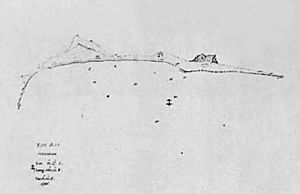
Before Hawaii was united under Kamehameha I, Niʻihau was ruled by local chiefs called aliʻi. One famous chief was Kahelelani. His name is now used for the Niʻihau kahelelani, a type of shell used to make beautiful Niʻihau shell jewelry.
Kāʻeokūlani was a chief who united the island after defeating his rival, Kawaihoa. A stone wall marked their lands. Eventually, Kāʻeo, with help from his brothers, won control of the whole island. Kāʻeo married Queen Kamakahelei, and their son, Kaumualiʻi, became a future king of Niʻihau and Kauaʻi.
In 1810, Kamehameha I had united all the Hawaiian islands except Kauaʻi and Niʻihau. After two failed attempts to conquer them, Kamehameha gathered a large fleet. Rather than fight, Kaumualiʻi, the last independent chief, surrendered. This brought Niʻihau into the unified Hawaiian Kingdom.
In 1864, Elizabeth McHutchison Sinclair bought Niʻihau and parts of Kauaʻi from Kamehameha V. She paid about $10,000 in gold. By 1875, Niʻihau had about 350 Native Hawaiians and 20,000 sheep.
This time also saw the end of a special Hawaiian art: mat-weaving. The makaloa plant, a native sedge, grew by Niʻihau's lakes. Its stems were used to weave moena makaloa (mats), which were considered the best sleeping mats in Polynesia. However, by the late 1800s, Hawaiians stopped making these mats due to changes in their lives and environment.
In 1915, Aubrey Robinson, Elizabeth Sinclair's grandson, closed the island to most visitors. Even family members of the residents needed special permission to visit. The island has been passed down through the Robinson family. Today, Bruce Robinson and Keith Robinson are the co-owners.
Niʻihau played a small part in World War II after the attack on Pearl Harbor in 1941. A Japanese pilot crash-landed on the island. This event, called the Niihau Incident, involved the pilot getting help from some local residents of Japanese descent. He was later killed.
Niʻihau has a long connection with the U.S. military. There is a small Navy base on the island. No military staff live there permanently. However, the U.S. military uses the island for training special operations units. They even hire Hawaiians from Niʻihau to act as "enemy" trackers.
Life on Niʻihau

The 2010 census reported 170 people living on Niʻihau. However, some people who have visited believe the population is closer to 35 to 50 residents. Many residents support themselves by fishing and farming. Others receive welfare. Everyone lives rent-free, and meat is also free.
Niʻihau has no telephone service or paved roads. Horses are the main way to get around, and bicycles are also used. There are no power lines; solar power provides all electricity. The island has no plumbing or running water. Water comes from collecting rainwater. The Robinson family set up most of these conditions. There are no hotels. Barges bring groceries from Kauaʻi, often bought by relatives, with free shipping.
Residents usually speak the Niʻihau dialect of Hawaiian as their first language. This was encouraged by the original purchase contract, which asked the owners to help protect Hawaiian culture. The Niʻihau dialect is different from modern Hawaiian. For example, the "k" sound is often pronounced like a "t." Niʻihau is the only island where Hawaiian is spoken as the main language. English is their second language.
Some residents have radios and TVs, but TV reception is limited. Niʻihau often has droughts, which sometimes force people to move to Kauaʻi temporarily. They return when there is enough rain. Residents often travel to Kauaʻi for work, medical care, or school. Many consider both islands home. The island owners have a helicopter for emergencies and to transport Navy contractors and residents to and from Kauaʻi. Helicopter tours and safaris help pay for this service.
A special type of art using gourds (a type of fruit) developed only on Niʻihau. A design is carved into the fresh gourd's skin. Then, it is filled with dye. After several weeks, the dye changes the color of the uncarved parts of the gourd. Hawaiian music is very important on the island. Singers often use only two or three notes with changing rhythms. Playing the ukulele and guitar is common among the islanders. There are also three styles of slack-key music.
Education on Niʻihau
The Hawaii Department of Education runs the Niʻihau School. This school teaches students from kindergarten to 12th grade. Along with regular subjects and computer skills, students learn how to "thrive from the land." The school uses only solar power. The number of students changes often, from 25 to 50, because families travel between Niʻihau and Kauaʻi.
Schoolchildren can stay with relatives in west Kauaʻi. There, they attend one of two public charter schools that focus on Niʻihau. At the Ke Kula Niʻihau o Kekaha school, students speak the Niʻihau dialect in early elementary grades. Then, they learn Hawaiian and English up to grade 12. This school has recording equipment to help save and teach traditional Niʻihau and Hawaiian culture.
At the other west Kauaʻi school, Kula Aupuni Niʻihau a Kahelelani Aloha (KANAKA), English is used in all grades. However, it still supports the Niʻihau dialect. Both schools work to keep the culture, values, and spirituality of Niʻihau alive.
Economy of Niʻihau
About 80% of Niʻihau's money comes from a small Navy base. This base is on top of 1,300-foot-high cliffs. Remote-controlled devices are used there for testing and training with Kauaʻi's Pacific Missile Range Facility. Modern missile defense tests for the U.S. and its allies happen at this site. The base brings in millions of dollars each year. This gives the island a steady income without needing a lot of tourism or factories.
Selling shells and shell jewelry is another way people earn money. Niʻihau's beaches are famous for their tiny shells, called pūpū. These shells wash ashore during winter. Shells used for leis include momi, laiki (rice shells), and kahelelani. These shells and jewelry are so popular that a law was signed in 2004 to protect lei pūpū o Niʻihau (Niʻihau shell leis) from fakes. A single, detailed Niʻihau shell lei can sell for thousands of dollars.
Many Niʻihau residents used to work for Niʻihau Ranch, raising cattle and sheep. However, the Robinsons closed this operation in 1999 because it was not making money. Honey farming also stopped being profitable by 1999. Selling kiawe charcoal was once a big business, but competition from Mexico ended that too.
Raising mullet fish has been popular on Niʻihau. Ponds and lakes are filled with baby mullet. They grow to be about 9-10 pounds (4-4.5 kg) before being caught and sold on Kauaʻi and Oʻahu.
Bruce Robinson, one of Niʻihau's owners, is looking for new ways to make money that won't harm the island. He is considering things like making jet fuel, more military uses, and windmill energy. He has refused offers to buy sand from Niʻihau's beaches because it would damage the environment.
Tourism on Niʻihau
Since 1987, Niʻihau's owners have offered half-day helicopter and beach tours. However, visitors do not have contact with residents, and there are no places to stay overnight. Since 1992, hunting safaris have also been offered. Tourists pay to visit the island and hunt animals like eland, aoudad, oryx, wild sheep, and boars. Any meat that hunters do not take is given to the village.
Niʻihau in Popular Culture
- The final missions in the 2007 video game Supreme Commander and its expansion, Supreme Commander: Forged Alliance, happen on Niʻihau. The island in the game has a superweapon called Black Sun. The game shows the island somewhat correctly and includes some made-up islands around it.
- The 2019 film Enemy Within tells the story of the Niʻihau Incident.
Images for kids
-
Location of Niʻihau in the state of Hawaiʻi
-
Map of Yam Bay and Niʻihau, Captain George Dixon's Journal, 1788.
-
Navy contractors from PMRF arrive at Paniau Ridge on Niʻihau in an Agusta A109 helicopter. The seabird sanctuary island of Lehua can be seen in the background.
See also
 In Spanish: Niʻihau para niños
In Spanish: Niʻihau para niños


